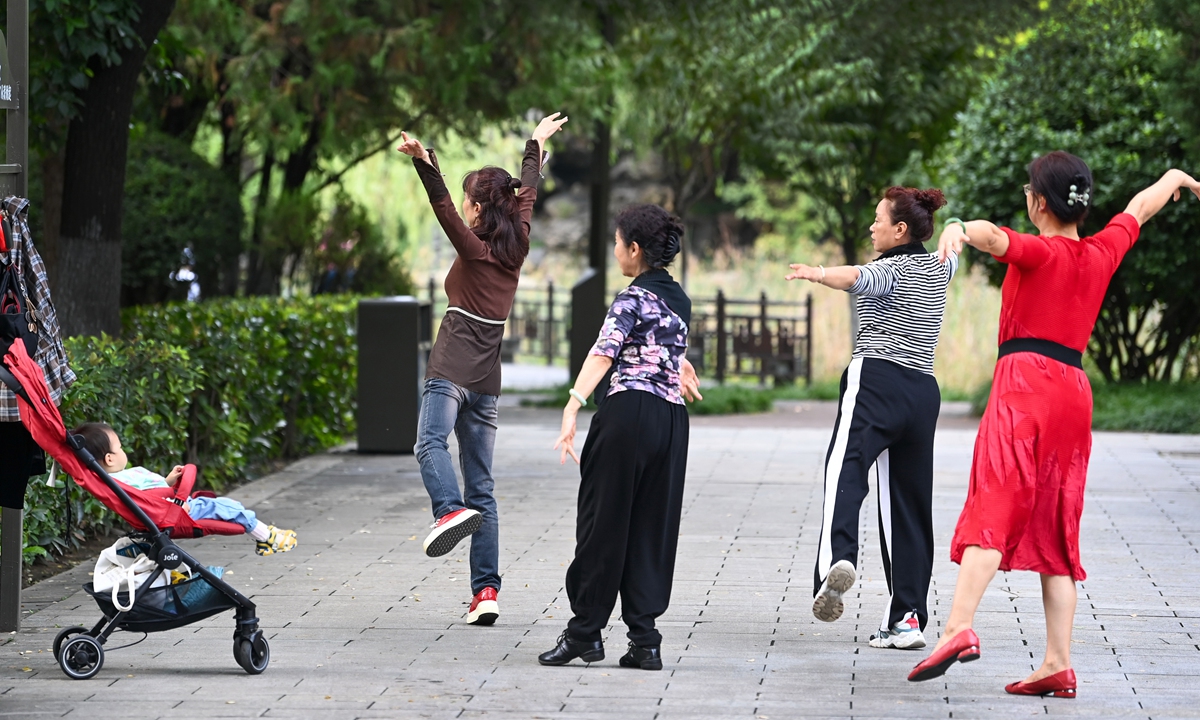
Several citizens dance to the music inside a square in Xi'an, Northwest China's Shaanxi Province. Photo: VCG
From hip-hop street dance and modern dance favored by young people to ethnic folk dance with strong regional color, square dance teams from all over the country staged a visual feast in Guiyang, Southwest China's Guizhou Province on Sunday.
Guizhou, a province that unexpectedly became popular for hosting the National Beautiful Rural Basketball Tournament, a grassroots basketball tournament known as "Village BA," was chosen as the venue for the National Square Dance Competition, or the Square Dance Night.
The National Square Dance Competition, held in stages across China, began in Beijing in June and saw provinces and regions organize their local square dance championships. It culminated with 25 top square dance teams out of 100 teams from across the country showcasing their talents at the grand Square Dance Night.
Square dancing, also known as guangchangwu in Chinese pinyin, is a well-liked kind of physical activity and social interaction in which groups of people - mostly the elderly - dance to music in parks, plazas, and public squares.
In an attempt to keep fit and active, they often come together, usually after supper, to practice simple dance skills. The self-organized square-dancing crowds in every city are a distinctive feature of China for outsiders who have just arrived.
But now, it has been recognized by an even wider scope of audiences through the efforts of China's Ministry of Culture and Tourism.
"It (the Square Dance Night event) showcased the diversity and charm of Chinese cultural life, inherited the essence of Chinese traditional culture, and promoted innovation and development of Chinese square dancing," Beijing-based sociologist Tang Shu told the Global Times on Monday.
"It also provided a platform for exchange and learning for the vast number of square dance enthusiasts and inspired their passion and confidence for square dance," Tang added.
Mutual reinforcementBy hosting the Village Super League and the National Beautiful Rural Basketball Tournament, Guizhou has found the grassroots popularity of the events also brought huge cultural benefits.
During the basketball tournament in March, a total of 30,000 people swarmed into Taipan village. The on-site intangible cultural heritage market presented a series of cultural and creative products designed with ethnic culture, including Miao embroidery, paper-cutting, hats, bags and other daily necessities.
Similar benefits are also expected to be reflected in the square dance activities.
For example, the selected square dance work "Joyful Ordos" used a new creative concept that ingeniously integrated the classic shoulder, arm and wrist elements of Mongolian dance with the rhythm and cultural connotations of northern China.
The music was selected from two classic folk songs - "Wine Song" and "Round Hat" - in the national intangible cultural heritage project Ordos Short Tune Folk Songs. The smooth melodies complemented the graceful dancing.
To promote local culture and attract crowds, this event offered souvenirs such as postcards with Guizhou landmarks and thematic maps. On-site displays included folk crafts such as Miao embroidery, batik, and silver jewelry. Local distinctive delicacies like laziji (spicy chicken) and niurou fen (rice noodles with beef) were also presented. A guide to leisure activities in Guiyang, the capital of Guizhou, was provided, connecting roadside concerts, music festivals, sports events, and more cultural and sporting activities.
An active platformChinese squaredancing has undergone a remarkable transformation since its inception. The rise of square dancing initially brought about issues like noise. However, in order to enrich people's recreational activities, the country introduced square dance competitions and also implemented various measures to make the activity more standardized while also providing the elderly with a vibrant source of entertainment.
In 2017, the General Administration of Sport issued a notice regulating square dance activities and banned excessive noise that disrupted schools and residents' lives.
To further combat the conflicts arising from the popular activity, other measures have been implemented in some areas.
For instance, a county in Lanzhou, Northwest China's Gansu Province, issued a notice in May requiring organizers and participants of square dancing and livestreaming events to strictly control the volume of their sound systems and halt activities after 9 pm.
In Beijing's Fengtai district, a pilot program was launched on June 20 at the Songjiazhuang subway station square, where directional speakers have been installed. These systems not only play energetic songs for square dancing enthusiasts but also create quiet zones for nearby residents by bringing dancers to a specific area, fostering a coexistence between the square dancing and residential life.
In addition to noise levels, competition for venues between sports enthusiasts and dancers has also been an issue. One of the solutions, said Peng Fuwei, deputy director of the Social Development Department at the National Development and Reform Commission, is to ensure that there is enough public space for both square dancers and sports enthusiasts like basketball players to avoid conflict over the venues.
As a result, according to a plan developed in 2021 by the Commission and other departments, a total of 1,000 more sports parks are set to be constructed in cities across China.
The evolution of Chinese square dancing is not just reflected in park construction, regulations, or innovation of dance forms. More importantly, its diversity has helped more people to embrace it, which ensures its sustainability in society today.
It is also becoming more modern. Dancers, most of whom are middle-aged and retirees, are now dancing to K-pop and other popular forms of music, which has attracted the attention of youngsters.
"I think the square dancing [competition] is a good thing as for the elderly, it is more than a leisure activity but a way to satisfy the need to socialize," a 70-year-old grandmother surnamed Wang told the Global Times as her trio team rehearsed a dance.
"The competition gives people a stage to perform, which is what we need," she added.